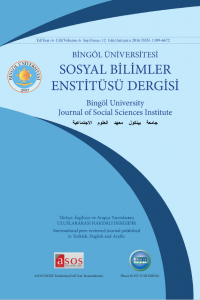Abstract
The article presents theoretical and methodological approaches to the construction of the conceptual psychological model of making strategic life decisions by students in three areas: professional self-determination, choice of a marriage partner and determination of life position of the individual; determines the basic stages, indications, criteria and psychological mechanisms of this process. The conclusions summarized that the use of the model in practice allows to specify the basic indications and criteria of the personality readiness to making strategiclife decisions by students, to make the diagnosis of this process and to develop the appruopriate programs of psychological and pedagogical training of students to making strategic life decisions. The knowledge, abilities, skills and understanding of students the necessity of preparing for making the mentioned decisions will allow them to avoid frustrations in building their own life path.
References
- ABULHANOVA, K.-SLAVSKAYA, A. (1991). Life Strategy. Moskow: Misl` (in Rus.)
- ARNOL`D K. (2014). Small Move, Big Change: Using Microresolutions to Transform Your
- Life Permanently. Moskow: Mann, Ivanov I Ferber (in Rus.)
- BALL G. O. (2007). Landmarks of modern humanism (in the social, educational, psychological areas). Kyiv-Rivne: Vidavets Oleg Zen` (in Ukr.)
- BEH I. D. (1995). The will of the individual. Kyiv: Ukraina-Vita.
- GROT N. Ya. (1882). On the question of the reform of logic. Experience a new theory of mental processes. Leipsig (in Germ.)
- POMITKINA L. V. (2013). Psychology of personality to making strategic life decisions: monograph. Kyiv: Kafedra (in Ukr.)
- POMITKIN E. O. (2012). Psychology of spiritual development. Monograph. Kyiv: Vnutrishniy Svit (in Ukr.)
- SOHAN` L. V. (2010). Zhiznetvorchestva Arts. Purpose. Zhiznetvorchestva. Fate: Sociological essays, social and psychological essays, interviews, and a glossary. Kyiv: Izdatel`skiy Dom Dmitriya Burago (in Ukr.)
- TIHOMIROV O. K. (1977). Psychological mechanisms of goal formation. Moskow: Nauka (in Rus.)
- ADLER A. (1968). The cours of human life as a psychological problems. – Human Development, 3,184-200.
- LYUBOV, POMYTKINA. (2013). Personal readiness of youth to making strategic life decisions // European Applied Sciences. – Germany (Stuttgart), May, 5, 155-157.
- MASLOW A. (1987). Motivation and personality (3 rd ed.). New York: Harper and Row.
- SARI E. (2008). The Relations Between Decision Making in Social Relationships and Decision Making Styles. World Applied Sciences Journal, 3(3), 369–381.
Abstract
Bu makale öğrencilere yönelik stratejik hayati kararlar verirken kavramsal psikolojik modelin yapısı ile ilgili uygulanan teorik ve metodolojik yaklaşımlarını, ‘mesleki olarak bireyin kendini idare edebilmesi, evleneceği eşi seçebilmesi ve hayattaki konumunu kararlaştırması’ olmak üzere üç farklı alanda inceler ve ayrıca tüm bu aşamaların ana hatlarını, bulgularını, kriterlerini ve psikolojik mekanizmalarını ortaya çıkarır. Ortaya çıkan sonuçlar bu modelin gerçek hayatta kullanımı öğrencilerin uygun psikolojik ve pedagojik eğitimlerini geliştirmek ve bu aşamaların tanısını koymak için öğrencilere yönelik stratejik hayati kararlar vermede gönüllük ana belirtilerinin ve kriterlerinin belirlemesine izin verdiğini kısaca özetlemektedir. Öğrencilerin bilgileri, yetenekleri, becerileri ve anlayışları, mezkûr kararları verebilmek için gerekli olan hazırbulunuşluk onların kendi geleceklerini inşa ederken hüsrana uğramaktan alıkoyacaktır.
References
- ABULHANOVA, K.-SLAVSKAYA, A. (1991). Life Strategy. Moskow: Misl` (in Rus.)
- ARNOL`D K. (2014). Small Move, Big Change: Using Microresolutions to Transform Your
- Life Permanently. Moskow: Mann, Ivanov I Ferber (in Rus.)
- BALL G. O. (2007). Landmarks of modern humanism (in the social, educational, psychological areas). Kyiv-Rivne: Vidavets Oleg Zen` (in Ukr.)
- BEH I. D. (1995). The will of the individual. Kyiv: Ukraina-Vita.
- GROT N. Ya. (1882). On the question of the reform of logic. Experience a new theory of mental processes. Leipsig (in Germ.)
- POMITKINA L. V. (2013). Psychology of personality to making strategic life decisions: monograph. Kyiv: Kafedra (in Ukr.)
- POMITKIN E. O. (2012). Psychology of spiritual development. Monograph. Kyiv: Vnutrishniy Svit (in Ukr.)
- SOHAN` L. V. (2010). Zhiznetvorchestva Arts. Purpose. Zhiznetvorchestva. Fate: Sociological essays, social and psychological essays, interviews, and a glossary. Kyiv: Izdatel`skiy Dom Dmitriya Burago (in Ukr.)
- TIHOMIROV O. K. (1977). Psychological mechanisms of goal formation. Moskow: Nauka (in Rus.)
- ADLER A. (1968). The cours of human life as a psychological problems. – Human Development, 3,184-200.
- LYUBOV, POMYTKINA. (2013). Personal readiness of youth to making strategic life decisions // European Applied Sciences. – Germany (Stuttgart), May, 5, 155-157.
- MASLOW A. (1987). Motivation and personality (3 rd ed.). New York: Harper and Row.
- SARI E. (2008). The Relations Between Decision Making in Social Relationships and Decision Making Styles. World Applied Sciences Journal, 3(3), 369–381.
Details
| Subjects | Psychology |
|---|---|
| Journal Section | Articles |
| Authors | |
| Publication Date | November 15, 2016 |
| Published in Issue | Year 2016Volume: 6 Issue: 12 |



